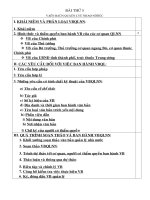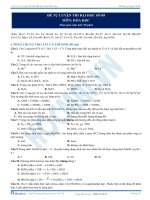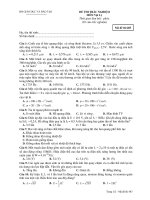PASSAGE 5
Bạn đang xem bản rút gọn của tài liệu. Xem và tải ngay bản đầy đủ của tài liệu tại đây (42.24 KB, 3 trang )
PASSAGE 5
The penny press, which emerged in the United Sates during the 1830’s, was a powerful agent of mass
communication. These newspapers were little dailies, generally four pages in length, written for the mass
taste. They differed from the staid, formal presentation of the conservative press, with its emphasis on
political and literary topics. The new papers were brief and cheap, emphasizing sensational reports of
police courts and juicy scandals as well as human interest stories. Twentieth – century journalism was
already foreshadowed in the penny press of the 1830’s.
The New York Sun, founded in 1833, was the first successful penny paper, and it was followed two years
later by the New York Herald, published by James Gordon Bennett. Not long after, Horace Greeley issued
the New York Tribune, which was destined to become the most influential paper in America. Greeley
gave space to the issues that deeply touched the American people before the Civil War – abolitionism,
temperance, free homesteads, Utopian cooperative settlements, and the problems of labor. The weekly
edition of the Tribune, with 100,000 subscribers, had a remarkable influence in rural areas, especially in
Western communities.
Americans were reputed to be the most avid readers of periodicals in the world. An English observer
enviously calculated that, in 1829, the number of newspapers circulated in Great Britain was enough to
reach only one out of every thirty – six inhabitants weekly; Pennsylvania in that same year had a
newspaper circulation which reaches one out of every four inhabitants weekly. Statistics seemed to justify
the common belief that Americans were devoted to periodicals. Newspapers in the United States
increased from 1,200 in 1833 to 3000 by the early 1860’s, on the eve of the Civil War. This far exceeded
the number and circulation of newspapers in England and France.
Question 1. What is the author’s main point in the first paragraph?
A. The penny press became an important way of disseminating information in the first half of the
nineteenth century
B. The penny press was modeled on earlier papers
C. The press in the nineteenth century reached only a small proportion of the population
D. The penny press focused mainly on analysis of politics
Question 2. What does the author mean by the statement in the first paragraph that twentieth- century
journalism was foreshadowed by the penny press?
A. The penny press darkened the reputation of news writing
B. Modern news coverage is similar to that done by the penny press
C. Twentieth – century journalism is more important than nineteenth- century journalism
D. Penny – press news reporting was more accurate than that in twentieth – century newspapers
Question 3. Which of the following would LEAST likely be in a penny-press paper?
A. A report of theft of union funds by company officials
B. An article about a little girl returning a large amount of money she found in the street
C. A story about land being given away in the West
D. A scholarly analysis of an economic issue of national important
Question 4. Who was Horace Greeley (paragraph 2)?
A. The founder of the penny – press paper that did the most to influence the thinking of the public
B. The publisher of the first penny-press paper to make a profit
Page 1
C. The most successful writer for the penny press
D. The man who took over James Gordon Benette’s penny – press paper and made it successful
Question 5. The word “remarkable” in the second paragraph is closest in meaning to ________
A. discussable
B. remote
C. significant
D. uneven
Question 6. The word “avid” in the third paragraph is closest in meaning to________
A. intelligent
B. critical
C. thrifty
D. eager
Question 7. The figures concerning newspaper circulation in Pennsylvania in 1829 are relevant because
they ________
A. explain why so many different periodicals were published
B. support the belief that Americans were enthusiastic readers of periodicals
C. prove that weekly periodicals were more successful than daily papers
D. Show the difference between reading habits before and after the Civil War
Question 8. The word “justify” in the third paragraph is closest in meaning to ________
A. prove
B. generate
C. calculate
D. modify
Question 9. The third paragraph is developed primarily by means of________
A. descriptions
B. analysis of a process
C. contrasts
D. ordering events in time sequence
Question 10. IT can be inferred that penny-press newspapers were all of the following
EXCEPT________
A. inexpensive
B. profitable
C. informal
D. thorough
ĐÁP ÁN
1-A
2-B
3-D
4-A
5-C
6-D
7-B
8-A
9-B
10-D
LỜI GIẢI CHI TIẾT
Question 1:
“The penny press, which emerged in the United Sates during the 1830’s, was a powerful agent of mass
communication”
Question 2:
“Twentieth – century journalism was already foreshadowed in the penny press of the 1830’s”
→ Modern news coverage is similar to that done by the penny press
Question 3:
“The new papers were brief and cheap, emphasizing sensational reports of police courts and juicy
scandals as well as human interest stories”
Question 4:
“Horace Greeley issued the New York Tribune, which was destined to become the most influential paper
in America”
Question 5:
“Remarkable” = “significant”: quan trọng
Page 2
Question 6:
“avid” = “eager” : háo hức
Question 7:
“Statistics seemed to justify the common belief that Americans were devoted to periodicals.”
Question 8:
“justify” = “prove” : chứng tỏ, minh chứng cho
Question 9:
Đoạn 2 nói về tầm ảnh hưởng của tờ “penny – press” đối với công chúng Hoa Kỳ. Và đoạn 3 trên cơ sở
đó phân tích sâu hơn với các con số minh chứng cụ thể (analysis of a process)
Question 10:
“These newspapers were little dailies, generally four pages in length, written for the mass taste. They
differed from the staid, formal presentation of the conservative press, with its emphasis on political and
literary topics. The new papers were brief and cheap, emphasizing sensational reports of police courts and
juicy scandals as well as human interest stories.”
Page 3









